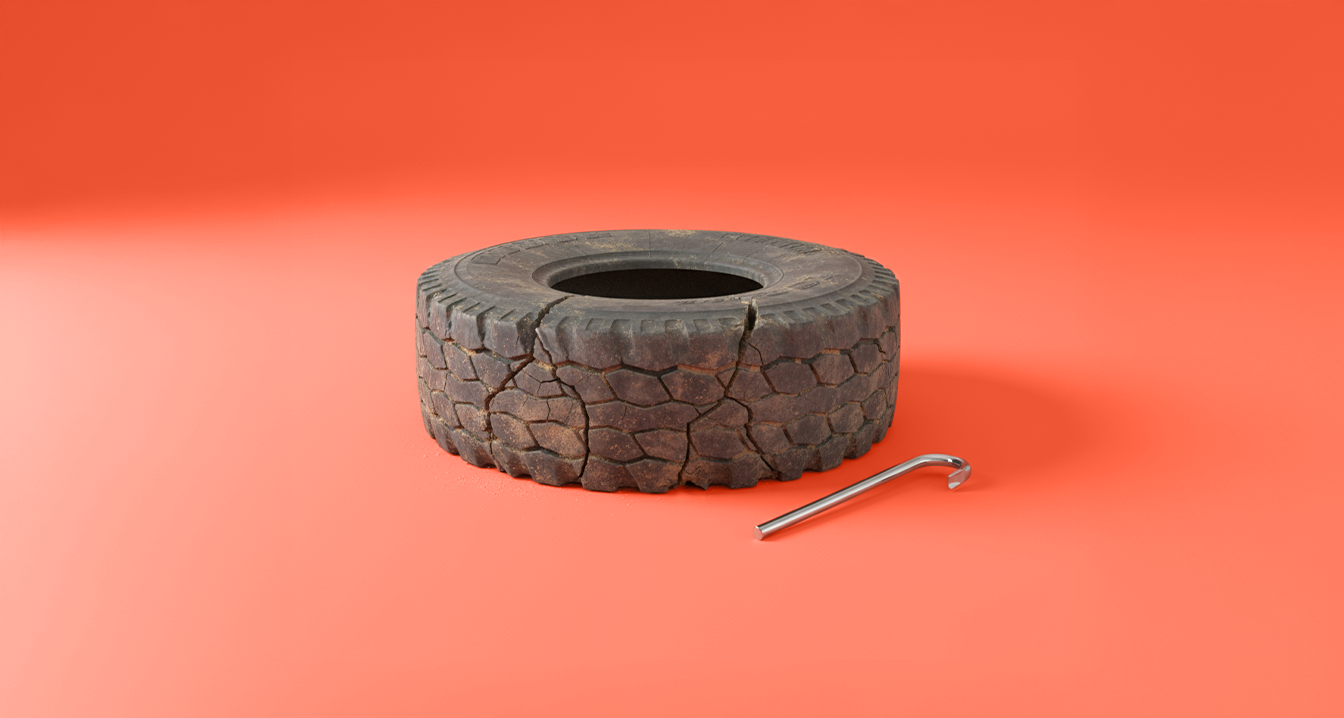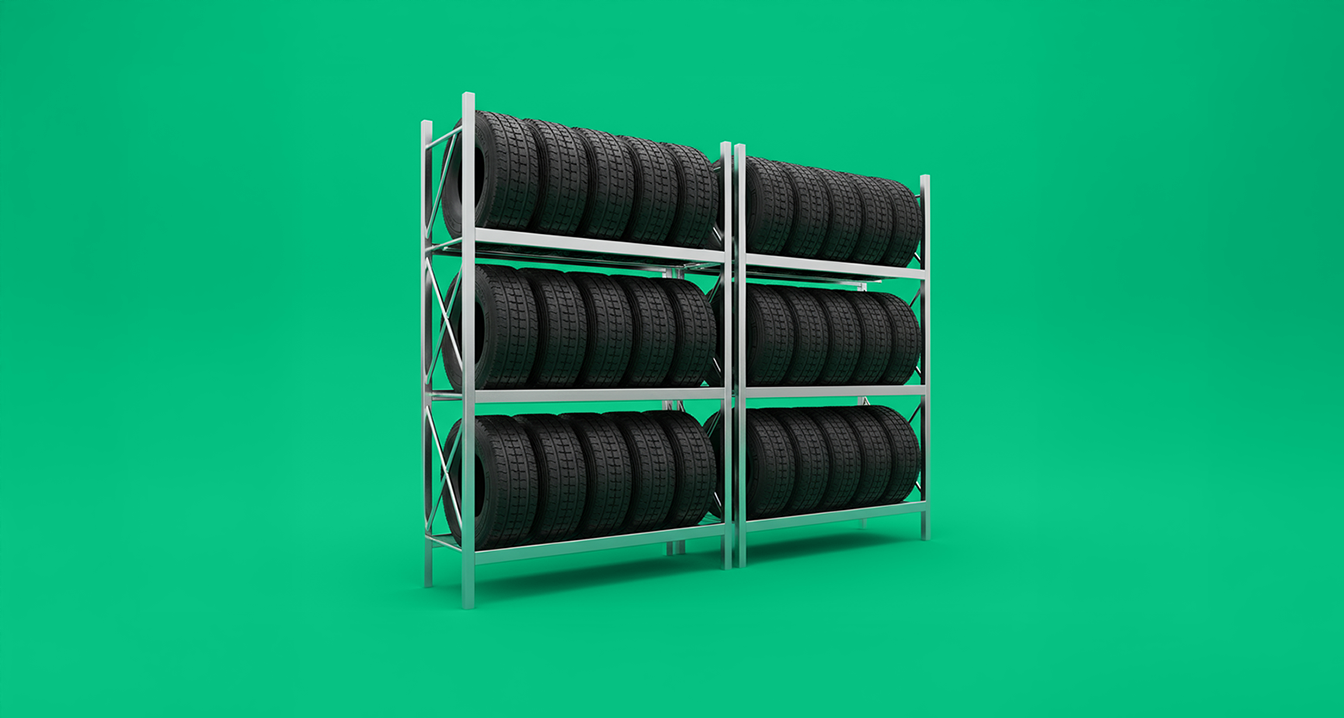Tires are the only vital point of contact between your truck and the asphalt that represents the road. This vital task, whose impact on the performance of your truck during commercial trips cannot be overlooked. On the other hand, it can be the way to get you into many problems, especially since more than 30% of accidents between trucks and regular vehicles are caused by tire problems, highlighting the importance of choosing the right tire for the truck on the one hand and the appropriate road on the other hand. Thus, we understand that the relationship between the truck, the road and the tires is a cooperative consensual relationship. All conditions must be compatible in terms of the type of truck The type of tires depends on the type of road and the environment in which the truck operates. Thus, we reach the point of discussion in this article, which is that many users find it difficult to identify the type of tires suitable for their trucks between paved road tires and off-road tires. The reader may think that the difference is clear, but what is clear may be many subtleties that make the difference between these two types a fundamental difference that is considered the dividing line between safety and performance and between accidents and continuous faults.
From these points of view, we can say that tires for paved roads are designed in thin and precisely flat shapes in order to give them stability on roads, as well as narrow channels and grooves in the tread. Asphalt roads are rarely exposed to heavy water, mud and heavy obstacles, making them have very little need for expansion. On the other hand, we find tires for rough roads that are bulky and have very wide channels and grooves, all in order to be able to deal with terrain and rough terrain, which is full of dirt, sand and mud, making them suitable for performing this task, On the other hand, it is not effective in traveling on paved asphalt roads because it is huge and makes a loud noise.
The difference between road tires and off-road tires is the actual difference between the customer's needs and the work environment in which they work. All types of tires are designed to meet the customer's needs
What is the structure and infrastructure of the internal frame?
Before we dive into the details that differentiate tires and their types, we will look at the commonalities that are not without a tire, as tires of all kinds consist of several chemical compounds that come together to be the truck parking specialized in movement. Thus, it is important to know the layers that make up tires and know the nature of their composition with each other, and so we will come to them all from the surface to the depths.
First: the tread or the dress (Tread): It is the outer surface that touches the road and is responsible for dealing with different road surfaces, depending on its design and the distribution of grooves in it. It has a specific pattern consisting of channels and micro-grooves distributed in a thoughtful engineering manner. In tires that operate in mud or sand conditions, the channels and grooves are wider than in tires that operate in smooth surfaces or asphalt. Thus, the tread is the part responsible for fixing trucks and vehicles on their specified path in the network of commercial roads.
Second: Shoulders: Here comes the importance of this part, which is a durable attachment tool that connects the tread or coating to the sidewall of the tire, which is of course less durable than its counterpart. In addition, it plays a crucial role in normal and sharp turns, as it is the part that touches the ground in the event of a turn or lateral maneuver, giving trucks a higher quality of performance.
Third: Sidewall: It is the vertical wall that covers the side of the open tire to the sides of the truck. Its main function is to preserve the overall structure of the tire and provide additional protection to the internal structure, which includes the internal parts of the tires, providing stability and greater strength in the face of changing conditions, while its thickness is a key factor in the quality of its artwork.
Fourth: steel belts (Steel Belts): These are layers of durable steel threads that are interwoven and bonded under the tread layers, providing overall strength and stability to the tire, as well as providing a barrier against punctures or spikes.
Fifth: Structure (Carcass/Body Ply): The structure is the basis for building the internal and external frame because it is the direct support for other composite materials. It is made of polyester, rayon or nylon depending on each manufacturer. It is dipped in rubber, giving it a high plasticity, thus being able to resist internal air pressure in an excellent manner, providing protection from punctures, cracks and other imminent damage.
Sixth: the inner liner (Inner Liner): It is an inner rubber layer designed to be air resistant and replaces the inner tube in modern tires (Tubeless), which is the most common in recent years. This lining is the last barrier to resist punctures and shocks, while being the barrier in direct contact with air.
Internal tire fitting is not just a review of information. It is the basic examination to know the quality of the product, so the quality of the manufactured materials inevitably means higher quality of the products

What do you know about On-Road/Highway Tires?
Road tires come with many features that are limited to their operation on flat ground and straight asphalt roads. This is reflected in the internal and external design of the tire, as it applies to the needs for which the tire was made. Next, we will address all the parts related to road tires, including design, performance, etc.
Designing tires for paved roads:
- Tread or coat: On paved road tires, they are relatively softer and have multiple, close and symmetrical grooves and channels in a specially designed geometric shape, giving the tire the maximum level of grip on the road, which can be asphalt or concrete road. The nature of the distribution of the shape of the tread is either symmetrical (Symmetric) or directional (directional) in order to drain water and reduce noise, while vertical and horizontal grooves are balanced to reduce rolling resistance and improve road stability more and more qualitatively.
- Shoulders and sidewall: The shoulders are less prominent and more rounded to provide smooth transmission of forces during turns and improve driving quality and driver comfort, while the sidewall is relatively thinner and more flexible to absorb bumps and improve driver riding, and is often designed to reduce the resistance of air flowing towards the truck.
Target vehicles for paved road tires:
Road tires target many small and medium vehicles and trucks, including sedans, hatchbacks, multi-purpose cars (CUVs), SUVs (SUVs) that are used mainly in the city and commercial highways, and pickup trucks (pickups) used for commuting rather than hard work.
The outstanding performance of road tires:
Paved road tires are characterized by their excellent grip on hard surfaces such as asphalt and concrete. This is because the rubber used in these tires is softer than others, in addition to the tread patterns and the geometric distribution of grooves and channels, providing a higher level of traction and stability during acceleration, braking, turns and sudden braking, making them withstand the harshest environmental and climatic conditions while maintaining the required grip and performance. This simply makes today's paved road tires the most sought after tires in the Arabian Gulf, as the Gulf road network is superior in terms of street distribution Asphalt, paving dirt roads and others.
On the other hand, we can say that road tires provide high comfort while driving, thanks to the flexible sidewall that reacts to the road quickly and without causing noise, in addition to the smooth and slightly thick tread design, which regulates driving and reduces external noise significantly, as well as the high ability of tires to withstand bumps and resist vibrations, making road tires an important part of vehicles that operate inside cities, as they produce the lowest level of noise in streets and internal roads.
Last but not least, road tires are fuel-friendly. They are among the tires that reduce fuel consumption. The formula is simple. Give me a flexible, thin, stable tire on the track. I give you less fuel consumption. This is due to the fact that these qualities make tires less resistant to rolling, therefore lighter on the engine and less likely to generate driving force. Therefore, tires intended for paved roads are of long life. Although the tread is thin, it is tough and durable compared to many off-road pedals, while the thinner grooves provide an age space A larger frame and an increase in the consumption limit, In addition to all this, it is generally less expensive than its off-road sisters, as these tires are specific to more specific work spaces.
At the end of this talk, we must point out the weaknesses of paved road tires, which are that they are very weak in the face of dirt, sandy and mud environments. They may have very poor chances of survival in these environments, in addition to being unable to deal with snow in cold areas. They are not suitable for adventures and road trips, especially as they are weak in front of sand, gravel and rocks because their side wall is flexible and subject to puncture, and their thin tires do not help them overcome sand and large and small gravel, which means that these tires, if purchased, should be used in the environment intended for them only, because Using it otherwise is a risk to money and lives.
The tires on the paved roads are the wolf that walks on its outskirts quietly, with a high level of stability on the track, and calm on the internal roads
What do you know about Off-Road Tires?
Off-road tires are the unknown warrior in rugged battlefields. These tires are distinguished from others by the fact that they are designed to support traffic on the most difficult roads, especially those dirt, sandy and mud roads, as well as construction areas, construction sites, etc., despite their large size and high visibility, in addition to the fact that the tread or the coating is very thick and may be twice the thickness of the tread in paved road tires. This large and irritating shape is one of the requirements of the work environment. Here, we need to provide a contact area with the ground and drainage channels for mud and water, making these tires suitable for the task for which they were made, In the following lines, we briefly explain the most important design details in the shape of the frame and its engineering design.
Off-road tire design:
- Tread or coat: The tread in off-road tires has a large area that touches the ground, thanks to the hard rubber blocks distributed over the tread, forming a fortified shield for the tire. The tread often consists of sharp-shaped blocks that grind rocks or stones. These small details make the difference in performance on the road.
- Grooves and channels: Off-road tires have very deep and relatively wide grooves and channels. They act as sewage pipes to get rid of mud, water and obstacles, giving tires high strength in dealing with slips in mud and heavy water. This is exactly what every truck driver needs to operate in muddy mud environments.
- AFor custom styles: In mud tires or mud tires, the tread is characterized by several very large and very solid blocks, with prominent shoulders on the side edge of the tire, reinforced with crocodile teeth, which are strong rubber blocks that contribute to protecting the sidewall of the tire from impacts and punctures. Rocky terrain tires are designed with a greater focus on strength and rigidity in resisting punctures while strengthening the sidewall to make it stronger, and close blocks on the tread to get greater stability on the road and improve driving.
- Side wall: The sidewall in off-road tires is an important part in the process of withstanding road conditions, as it is a flexible wall that reacts to the pressure ratio between the road and the truck. It is reinforced with additional double and triple layers to provide high resistance to punctures, scratches and tears when passing over sharp rocks or traveling with low air pressure to increase the contact area. It comes with distinctive designs that express strength and rigidity.
The outstanding performance of off-road tires:
High performance on rough roads is what attracts people to buy off-road tires because they resist mud and mud thanks to deep and wide grooves and divergent blocks that effectively expel mud material to the sides, providing a greater area of contact and friction, which in turn prevents slipping. When it comes to sand, the large surface area makes it easier to walk on sand, especially with reduced air pressure inside the tires, the truck will be able to travel completely freely on desert sand. On rocky roads, the sidewall provides full protection to the tires, thanks to High durability, which resists puncture and tearing, in addition to very hard tread or covering blocks that provide grip on the road because they put more pressure on the road. In general terrain, tires are designed in a way that provides high traction and a wide grip area, making tires suitable for climbing and climbing on hills and slopes.
These tires are specifically designed to be the off-road beast, making their manufacturers work to make them more resistant to damage, dents and punctures, giving them unparalleled performance on sandy, rocky and mud roads, which means that they are best suited for trucks that operate in construction sites and construction sites, as these areas are often mud, dirt or sandy. In addition, these tires make a loud sound if they travel on asphalt because they contain solid blocks in the treads.
Finally, it is worth noting the weak points that appear when tires travel on asphalt. They cause loud noise and increase with the speed of the truck, which means that they are not suitable for internal civil roads, in addition to their inability to resist bumps quietly. Despite their strength and rigidity, they are less flexible than paved road tires. They are the worst in fuel consumption because they provide a wide friction area and high traction force. They require a powerful engine and a lot of fuel.
Off-road tires are the lion that roars to show high power and a loud roar, but in the end they are the king of the jungle as well as off-road tires. They are the queen of difficult roads and the destroyer of impossible challenges
What tires do you really need?
The most important question for the reader remains “What are the right tires for my truck?” This question can be answered simply. First, you must know the driving rate. How far do you travel on paved roads? If it is 60-80%, you need to use multi-terrain tires, which are intermediate between mud tires and tires for paved roads. If your activities are in the city, rely on on-road tires, which are a very smart choice because they are less noisy and better in terms of life.
However, if you often visit rough roads and mud or sandy areas, you should rely on off-road tires, especially (M/T), which provide you with greater depth in the tread, which contributes to stabilizing the truck on the road, with many benefits for half-load car owners. They save you from getting stuck in sand, mud and mud, while giving the vehicle high speed and great traction.
What is Darbek Company?
Darbek Tire Company is an emerging Saudi company that has developed several types of truck tires to be suitable for the work environment in the Kingdom of Saudi Arabia and the Arabian Gulf. This came through a relentless effort to provide highly efficient engineering designs that can be applied on the ground, providing many of the features that drivers in Saudi Arabia have always requested and lacked. Efforts were successful, especially after the Saudi Organization for Standardization, Metrology and Quality issued the quality mark on Darbek tires, which is the first Saudi company to receive this mark, which represents the most advanced stages durability and strength.







